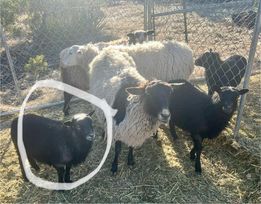I traded the yard art alpacas for meat sheep. Just starting out with Hodge podge but will breed to a Romanoff ram eventually. Here's my 4 starter ewes!
we'll call this girl Kat as she is a Katahdin/Dorper cross sheep. This is a hair sheep lives about 10-12 years and has 1-4 lambs at a time. Kat is 4 years old has lambed but not for me. Bought 2-20-24
feet trimmed 3-22-24, CDT shot given
this is mama Dorper/Katahdin cross with her lamb Valentine
Bought 2-20-24
no shots as of yet
this is a bottle lamb, Kiki 7 weeks on 2 bottles a day.
3-22-24 CDT shot

Romanoff lamb coming...Born 2/27/24 calling him Top Hat his mom is Five Oh that's his mama next to him and sire is at the top of the page in the heading. Arrived 4-11-24 @ 6 weeks 2 days

Notes to self
note to self...taking a temperature. Should be between 101.5 and 103.5. Any lower and the lamb needs warmed up. Any higher and the lamb has an infection and needs antibiotics.
Lambs can be weaned from milk feeding at 25-30 pounds body weight or when they are 30-45 days of age.
When can you stop bottle feeding lambs?
Whilst the recommended lamb weaning age is 12 to 14 weeks from the start of lambing, lambs can be weaned at 8 to 10 weeks or even earlier if appropriately fed and managed. Train lambs before weaning (imprint feeding) as it will be much easier to get them on a ration. Oct 14, 2020
About the Alpacas


About Alpacas
Alpacas are related to llamas and camels originating in South America. With triangular ears, eyes as big as golf balls and a neck like PVC pipe. Alpacas have long been sought after for their wool or fiber as it is commonly called. Their personality is more like a cat than a dog being more timid and curious, these are really beautiful creatures!
There are four types of camelids living in South America: the domestic llama, alpaca, wild vicuna, and the guanaco. The llamas are primarily pack animals, while the alpaca is valued for its fleece. Both, however, in some instances have been used as a source of food. All are related to the camels of Africa.
Alpaca fiber is similar to wool only it is much softer. A garment won't itch a bit ...retains heat better, is lighter in weight and stronger than wool....some say wicks away water and it fire resistant.
The ultimate goal of an Alpaca farmer is to breed the fiber of their alpacas up. The top most criteria is the fineness of its fiber. Fineness of fiber is figured in microns with one micron equaling 1/25,000 of an inch or 1/1000 of a millimeter....a micron count of less than 20 is very good...but as an industry we are breeding down as low as16 micron as cria/yearling. The micron generally grows with age although we are also breeding for lasting fineness and consitancy through out the life of the animal.
A start-up alpaca cost anywhere from $1500 for an older alpaca female with a micron value of 25 or greater...to maybe $10,000.00 and up for an alpaca with a low micron range. Top tier breeding male alpacas have micron range of 15-20. Blue ribbon breeding males can retail for as much as $1/2 million or more. a very nice male can be made or bought for much less.
Typically it takes 5 years before an alpaca farm becomes profitable. But if an owner can get his or her hands on a 1st rate breeding male the profit can get an early boost.
POTTY TRAINING
Alpacas all come potty trained. Alpacas innately deposit their fecal matter in a central location and there's hardly a smell! Should be cleaned up daily or so depending on the number of animals in the field for good husbandry.
GROOMING
There is no brushing or bathing or combing alpacas not even for the show ring! They stay clean and beautiful by taking dust baths! We shear once a year. During shearing an alpaca must be carefully restrained and sheared one side at a time. This is the time for nail clipping, teeth trimming, yearly shots, while harvesting the fleece.
FEED
An alpaca costs less than a large dog to feed. Six alpacas eat approximately 1 bale of orchard grass a week at the cost of maybe $30+ a bale depending on your locale...perhaps you grow your own pasture! The most import thing is plenty of clean water! A cup of alpaca pellets every other day and some free choice minerals and your alpaca will be healthy! Alpacas can tolerate more copper than sheep along the same lines as goats. CDT shot when shearing is recommended. Check teeth and trim hooves at this time.
VETERINARIAN
These are pretty hardy animals, but we all need a doctor at times, be sure you meet with a Vet before you bring your animals home in case of an emergency.